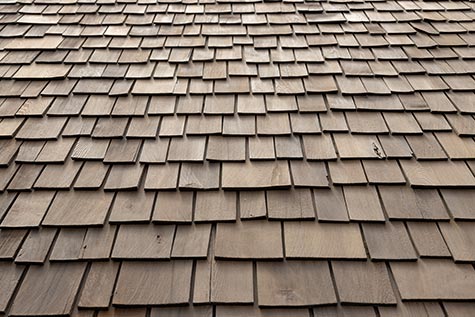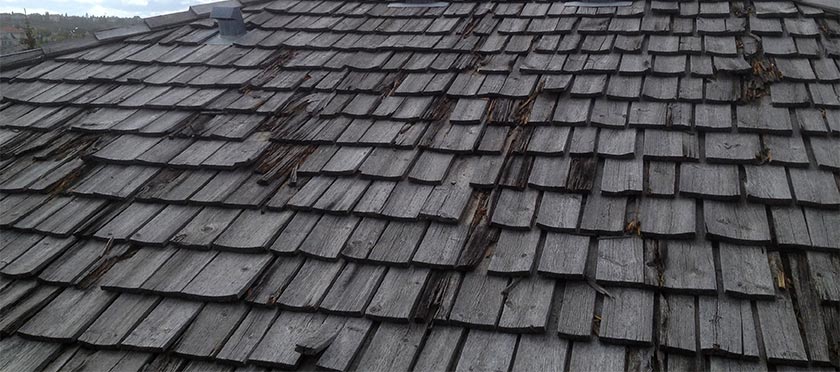Sure, a real wood shake or shingle roof looks nice. It has that warm, old world charm. Afterall, wood and thatch are among the oldest roof coverings. However, back then, humans didn’t have many roof options, not like we do today. And, today we know better. Although a wood shake or shingle roof looks nice, it’s not as eco-friendly as you might think. They’re also expensive and a fire hazard. There are many disadvantages to a wood shake or shingle roof. Want to know more about why you shouldn’t get that wood roof, or why you should replace your existing wood? Keep reading. 🙂

Not Eco-Friendly
Wood shingles and wood shake are always treated before they’re installed. Common preservative treatments include copper naphthenate and Cunapsol 5. Copper naphthenate is a preservative and by definition a pesticide. Cunapsol 5 is used to maintain a wood roof and to restore its decay-resistance. It consists of copper-naphthenate and is corrosive, and causes permanent eye damage and skin burns. It is extremely harmful if inhaled. Treated wood shake or shingles are not accepted at recycling centers we’ve contacted. Treated wood should not be burned due to the harmful fumes and smoke produced. Therefore, your treated wood shake roof goes straight to the local landfill.
Expensive
The average wood shake roof lasts about 25 years. On a 2500sf roof, wood shake will cost about $19,000 to install. Mid-grade asphalt shingles will cost you about $8,500 and last about as long. A metal roof, on the other hand, will only cost a little more than a wood shake roof, yet last twice to three times as long. Considering that wood lasts half to a third as long as metal yet costs about the same, that makes a wood roof very expensive.
Fire Hazard
From the factory, wood shake/shingles are treated to resist fire. However, that fire rating is only Class B. Class A is the highest fire rating. Most asphalt shingles have a Class A fire rating, and asphalt shingles have a combustable material in them – asphalt. Therefore, wood shake and wood shingles are not that resistant to fire even with their fire treatment. Being a fire hazard is among the biggest disadvantages of a wood shake or shingle roof.
Short Lifespan
Wood shake and wood shingles last about the shortest of any roof, along with 3-tab/strip asphalt shingles. The average wood shake or shingle roof lasts between 25 and 30 years if properly installed. With regular maintenance, a wood roof might last 30-40 years in ideal conditions and weather conditions. Wood shake or shingles that have been abused by hail or strong winds, or lengthy wet or humid conditions, that haven’t been regularly maintained and treated, won’t last as long. By comparison, most metal roofing, such as stone-coated metal shingles or standing seam, last 70 years or more.
Susceptibility
No other roof is more susceptible to rot, moss and mildew growth, splitting, insects, and fire than wood.
Fire
It’s no secret that wood burns. Wood shake and shingles are treated before installation to help resist fire. However, they need to be treated regularly to maintain their fire resistance. Do you know some municipalities ban wood roofs? And, some insurance companies may increase your rates if you have a wood roof. Contact us for a free consultation to determine if a wood roof is allowed in your city or town. Over the last several years, there have been many wild fires along the Front Range. Having a wood shake or shingle wood puts your home at risk.
Rot
When your wood roof gets wet from snow or rain, the underside of wood shingles and shake takes longer to dry. Wood absorbs moisture. The underside of your wood shingles or shake could stay moist for days. It’s in this humid environment, underneath the wood shake, where rot starts. A rotting wood roof is a deteriorating one, and increasingly provides your home with less protection from the elements. Rot can somewhat be prevented with regular maintenance.
Mold and Mildew
Mold and mildew isn’t as much of a problem here in Colorado, thanks to our relatively low humidity. However, if there’s a section of your roof that’s in the shade of a tree most of the time, that area can stay damp longer. This can lean to mold and mildew growth, which leads to the breakdown of your wood roof.
Insects
Insects love wood. If you have a wood roof, insects are attracted to it, especially wasps. Termites eat wood. Wood is a natural home for insects. Insects can breed under your wood shake or shingles and spread. Wood shingles and shake are treated before installation with Copper naphthenate, which is a pesticide. However, this pesticide doesn’t last forever. If your wood roof hasn’t been regularly maintained, you may have an insect problem.
Splitting
Wood shake and shingles are among the most vulnerable to splitting, such as from hail impacts. As wood shingles and shake dries-out over time, it becomes more susceptible to splitting. This is especially a problem here in Colorado thanks to our somewhat low humidity.

High Maintenance
Another big disadvantage of a wood shake or shingle roof is their high maintenance. A wood roof requires the most maintenance. In fact, they should be treated at least every 2 years to maintain resistance to mold, rot, insects, fire, etc. Pesticides applied to wood roofs last the longest, however, fire redardants do not. Fire retardants should be re-applied every few years. Wood shingles and shake roofs should be cleaned every few years, well, to remove any moss, mold, and algae growth.
The Bottom Line
As you can see, there are many disadvantages to a wood shake or shingle roof. They look nice, but that’s about it. There are better alternatives. A wood roof is among the shortest-lived, high-maintenance, combustible, not environmentally friendly, expensive, and vulnerable roofs on the market. If you’re wanting an eco-friendly roof, look at any metal roof. Also consider a metal roof if low long-term cost is your primary concern. If a natural looking roof is what you’re after, consider stone-coated metal shingles or tiles, or concrete or slate tiles.
